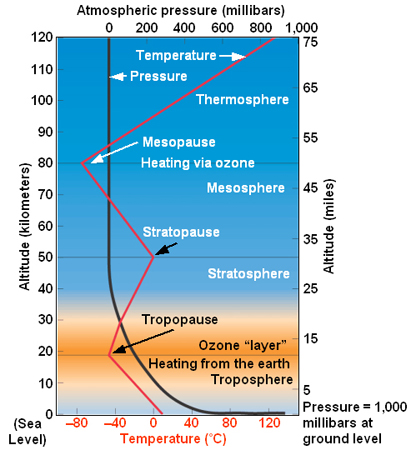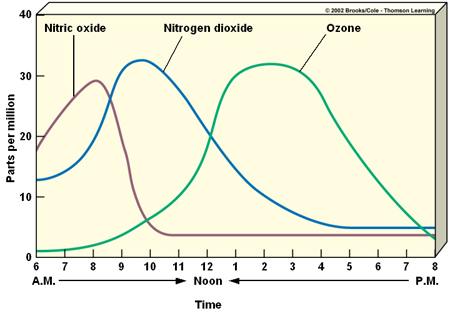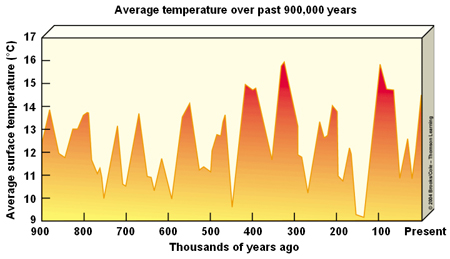Module 3.3 Atmosphere
The state of the atmosphere affects our health and influences our lifestyles. Australians consistently rank air pollution as a major environmental concern, and we gain a sense of wellbeing from clean, fresh air. The atmosphere provides ecosystem services indispensable for human life. For example, the atmosphere provides oxygen for us to breath, it absorbs and buffers the effect of solar radiation, it blankets the earth in nitrogen, which is essential for life.
Human impact on the atmosphere has been the focus of intense environmental, political, social and economic discussion internationally over the past two decades.
Topic Aims
In this topic we will learn about the:
- Composition and layers of the atmosphere
- Main sources of pollutants
- Major impacts of human activities on the atmosphere, in particular
- air quality and smog
- acid deposition
- enhanced greenhouse effect
- stratospheric ozone hole
![]()
What is the atmosphere?
The atmosphere is defined as the whole mass of air surrounding the earth. The atmosphere is divided into layers which are characterised by abrupt changes in temperature.
Note that the troposphere extends only 8 to 17 km above earth. This is where the earth’s weather occurs.

Activity 3.36
Read Miller & Spoolman (2012), pages. 466-468 and answer the following questions
- Distinguish between the atmosphere, the troposphere and stratosphere.
- What key role does the stratosphere play in maintaining life on earth?
![]()
Main sources of pollutants
Air pollution is the presence of one or more chemicals in the atmosphere in sufficient quantities and duration to
(i) cause harm to living things or materials
(ii) alter climate.

There are six criteria or common air pollutants and these are known to have harmful effects on human health: carbon monoxide, lead, nitrogen dioxide, ozone, particles and sulfur dioxide.
In Australia, the main sources of air pollution are automobiles and industry, particularly coal-burning power stations, oil refineries and aluminium smelters. For those interested, information on the national standards for these pollutants is available at the Department of Environment and Heritage ![]() .
.
The 2001 State of the Environment report found that there is "little evidence in the capital cities of Australia of air pollution problems arising from sulfur dioxide, nitrogen dioxide or lead. Present trends indicate that carbon monoxide is unlikely to be of concern in the future." Refer to the key findings in each section of the 2007 State of the Environment report for the current consensus on the state of air pollutants in our capital cities (Atmosphere Theme Report ![]() )
)
![]()
Major impacts of air pollution
Air pollution has significant impacts on the atmosphere at three levels: global, regional and local (DEST 1996).
- Global-scale impacts include the effects of long-lived gases and particles. It includes the enhanced greenhouse effect and stratospheric ozone depletion.
- Regional-scale impacts are the dispersion of pollutants within a regional airshed and their transport downwind. It includes emissions from cars and industrial plants.
- Local-scale impacts involves the pollutants that are contained within a confined area, or have limited dispersal from the site of emission. An example is indoor air pollution.
In this unit we will concentrate on 4 examples of air pollution:
- Photochemical smog
- Acid deposition
- The enhanced greenhouse effect
- Stratospheric ozone depletion
![]()
Photochemical smog
Many of you will have had the rather unpleasant experience of being in a city surrounded by slightly brownish air which is photochemical smog. Photochemical smog is essentially a mixture of nitrogen oxides and other chemicals formed under the influence of sunlight. Photochemical smog is a highly reactive gas that harms most living organisms. The nitric oxide that initiates the formation of photochemical smog is emitted from automobiles and industrial plants.
Activity 3.37
Read Miller & Spoolman (2012), pages 468-471.
- What four factors influence the formation of photochemical smog? What factors reduce air pollution?
- What is an air temperature inversion and under what conditions are they likely to form?
The South Australian EPA provides a factsheet “Photocemical smog – what it means for us” on their website www.epa.sa.gov.au![]() .
.
![]()
Acid deposition
Another consequence of atmospheric pollution is acid deposition. One form of this is commonly known as acid rain.
Activity 3.38
Read Miller & Spoolman (2012), pp. 476-480 and answer the following:
- What is acid deposition and what are its major components and causes? Distinguish between acid deposition, wet deposition and dry deposition.
- What are the major harmful effects of acid deposition on (a) human health, (b) materials (c) soils and (d) aquatic plants and animals, and (e) terrestrial plants and animals?
- List eight ways to prevent acid deposition and two ways to clean it up.
Acid deposition in Australia
Acid deposition is not a widespread problem in Australia, as sources are generally geographically isolated from each other. Unlike many northern Hemisphere countries, Australia is not subjected to significant air pollution from neighbouring countries. The major deposition process here is dry deposition of SO2.
One of the most significant sources of sulphate emissions in Australia is in Mt Isa where there are two large metal smelters. Sulphur dioxide is transported over savanna. A study by Tony Griffiths (Key Centre for Wildlife Management, CDU) and others found that SO2 emissions affected the savanna woodlands but the extent of the impact differed for various plant and animal groups. For example, plant species’ richness increased with downwind distance from the smelters, and the high-deposition zone had half the plant species and more leaf injury than low and background (upwind) zones. Emissions lowered ant, reptile and bird species’ diversity.
![]()
Enhanced greenhouse effect
I'm sure that you have all heard of the enhanced greenhouse effect. It is currently one of the most debated environmental issues, which has gained enormous international political attention. In this section we will learn about what the enhanced greenhouse effect is, what its effects might be, and ways in which to slow the effect.
Past climate change and the natural greenhouse effect
Throughout the earth’s history, there have been periods of global warming and global cooling. The earth has been in an interglacial period of fairly stable climate and average global surface temperature for the past 10,000 years.

![]()
Activity 3.39
Read Miller & Spoolman (2012), pp. 493- 504, and answer the following:
- What is the earth’s natural greenhouse effect? Use the diagram below to help you explain the theory.

- What is the natural cooling process that takes place near the earth’s surface?
- What are the two major greenhouse gases?
What is global warming?
Global warming is more correctly known as the enhanced greenhouse effect. It refers to the theory that the increase in CO2 and other greenhouse gases from human activities have enhanced the earth’s natural greenhouse effect leading to an increase in the temperature in the troposphere.
Activity 3.40
Read Miller & Spoolman (2012), pp. 493- 504, and answer the following:
- What are four human activities that increase the input of greenhouse gases into the troposphere?
- What are five measurements that suggest that the troposphere is getting warmer?
![]()
Support for the theory of enhanced greenhouse effect
Scientists are continually improving on climate models which are able to model past changes in climate and develop scenarios of future changes.
The IPCC is a panel of scientists from 70 nations and a many different disciplines to assess the current state of knowledge about climate change. On the basis of climate modelling, the IPCC report in 2001 concluded that there is a 90-95% chance that the earth’s mean surface temperature will increase 1.4-5.8°C between 2000 and 2100.
Not everyone agrees with the IPCC’s conclusion.
Activity 3.41
Read Miller & Spoolman (2012), pp. 493- 504, and answer
- What information do climatic skeptics use to argue against the IPCC’s conclusions?
Additional Web sites to visit which outline the arguments of skeptics of the enhanced greenhouse effect are:
The Science & Environmental Policy Project ![]()
We will hear both views on the enhanced greenhouse effect presented in the tutorial on this topic.
![]()
Activity 3.42
Based on what you have read in this chapter answer the following:
- How might the following enhance or dampen global warming?
- albedo
- the oceans
- air pollution
- effects of increased CO2 levels on plant photosynthesis, and
- increased methane emissions.
- How might planting more trees and conserving soils affect global warming, and what are the limitations of this approach?
- Why is understanding the length of time over which the temperature rises considered so important?
- What is the range of error in current projections of changes in the earth’s average atmospheric temperature?
![]()
Impacts of global warming
The scenario of increased CO2 and increased global temperature has led to many predictions about the impacts of global warming on humans and the environment. The International Panel on Climate Change (IPCC) concluded that climate change impacts will become increasingly negative for more of the world's regions and systems as the extent of global warming increases.
Activity 3.43
Read Miller & Spoolman (2012), pp. 504-510 and access the following Web sites:
Department of climate change and energy efficiency ![]()
Greenhouse & Climate change in the NT![]()
- Explain briefly how global warming may affect
- food production
- water supplies
- forests
- biodiversity
- sea levels
- weather extremes; and
- human health
- List some beneficial effects of global warming.
- List some effects predicted for Australia in the following table.
Factor that may be affected |
Description of predicted effect |
|---|---|
Temperature in 2030 and 2070 |
|
Annual average rainfall - 2030 & 2070 |
|
Number of hot days |
|
Sea level by 2100 |
|
Coastal recession of sandy beaches |
|
Frequency of storms & cyclones in NT |
|
Stream flow in northern & southern Australia |
|
River salinity |
|
Forests and Woodlands |
|
Wetlands (Australia and the NT) |
|
Alpine areas |
|
Agriculture |
|
Human health |
|
![]()
Possible solutions
There are three schools of thought as to how to address global warming
- The wait-and-see approach which advocates that more research be conducted before action is taken.
- Act now to reduce the risks from climate change brought about be global warming (this approach is rapidly gaining increasing support particularly through Europe and increasingly in Australia, especially recently).
- Act now as part of a no-regrets strategy (i.e. act now even if the threat of extensive global warming does not materialise because such actions lead to other important environmental, health and economic benefits).
Activity 3.44
Read Miller & Spoolman (2012), pp. 510-520 and answer the following:
- List and describe the characteristics of global warming which make it difficult to deal with.
- List five prevention methods, and five cleanup methods for slowing global warming due to increased greenhouse emissions.
- Describe the pros and cons of removing CO2 from the atmosphere or smokestacks and storing it in
- immature trees
- plants that store it in the soil
- deep underground reservoirs, and
- the deep ocean
Some Web sites that discuss some of these technologies are available at:
Victoria Department Of Primary Industries
ABC News Online - Geosequestration yet to be proven
Sciencebeat - Storing CO2 underground one option for mitigating greenhouse gases
Geotimes - Storing Carbon in SOli: Why and How?
- List five important ways that you could reduce your emissions of greenhouse gases.
![]()
The Kyoto Protocol
The Kyoto Protocol is an international treaty designed to limit global greenhouse gas emissions. Many Parties to the United Nations Framework Convention on Climate Change (UNFCCC), including Australia, have signed the Protocol since negotiations were concluded at the third session of the Conference of the Parties to the UNFCCC (COP 3). However, some countries, including Australia and the USA have not ratified the treaty.
![]()
Activity 3.45
Read Miller & Spoolman (2012), pp. 510-520 and access the Australian Government Web site: Kyoto Protocol ![]() web site.
web site.
- What are the two basic principles for dealing with climate change that were established by the Kyoto Treaty?
- What was the average target reduction for developed nations in the Protocol?
- What target was established for Australia?
- What are some of the reasons that Australia and the USA have given for not ratifying the Protocol?
![]()
Stratospheric ozone depletion
An environmental issue of major concern in the 1980s and 1990s was the depletion of ozone in the stratosphere.
Activity 3.46
Read Miller & Spoolman (2012), pp. 521 - 524 and answer the following:
- What is stratospheric ozone depletion, and how serious is this problem? What types of chemicals cause ozone depletion? How do these chemicals cause such depletion?
- Explain how seasonal ozone thinning occurs each year over the earth’s poles.
- For each of the following, list three harmful effects of ozone depletion:
- human health
- wildlife
- food and forest productivity
- air pollution
- What is the Montreal Protocol? List three reasons why getting countries to develop an international treaty and engage in other unified actions to reduce greenhouse gas emissions is much more difficult than it was for actions on stratospheric ozone depletion.
![]()
Review questions
- List five ecosystem services provided by the atmosphere.
- What is photochemical smog? What are some of its effects?
- List factors that are likely to (i) increase air pollution, and (ii) reduce air pollution.
- Define acid deposition. Identify the level of risk that acid deposition creates for ecological systems and for human health. List six strategies to prevent acid deposition.
- Describe the greenhouse effect and what the Earth would be like without a greenhouse effect. List the two predominant greenhouse gases. List four greenhouse gases which have risen in the last few decades. List four human activities which contribute greenhouse gases to the atmosphere.
- Distinguish between greenhouse effect and global warming.
- Briefly describe the pattern of the earth's average surface-temperature fluctuation throughout geologic time. What period has the earth experiencing for the last 10,000 years.
- Describe the general trend of mean global temperature since 1860. List two factors other than the greenhouse effect that may have contributed to the general temperature change.
- State the consensus science view about the relationship between observed temperature changes and the likelihood of global climate change brought on by human activities.
- Briefly describe projections of the major climate models regarding changes in mean surface temperature and average sea level. List three factors that affect uncertainty of these projections.
- Summarise the projections of possible effects of global warming on (a) food production, (b) water supplies, (c) forests, (d) biodiversity, (e) sea levels, (f) weather extremes, (g) human health, and (h) environmental refugees.
- Describe three schools of thought about global warming and how we as a human society should act. List seven strategies which would slow potential global warming, including both prevention and cleanup approaches.
- Describe the origin of stratospheric ozone and the role it plays in protecting life on Earth. Briefly describe changes which have been occurring in stratospheric ozone.
- Summarise the consensus science view of CFCs and stratospheric ozone.
Summarise alternative views that have received much attention. - Explain the significance of a critically thinking citizenry to the democratic process.
- Explain the potential consequences of ozone depletion. Propose three ways for slowing these changes.
- In 2001, the US President, George W Bush, announced that he would not support the Kyoto Protocol. Immediately following his statement, you are asked to advise Australia?s Environment Minister on an appropriate policy response. Describe and justify what policy response you would propose?
![]()
